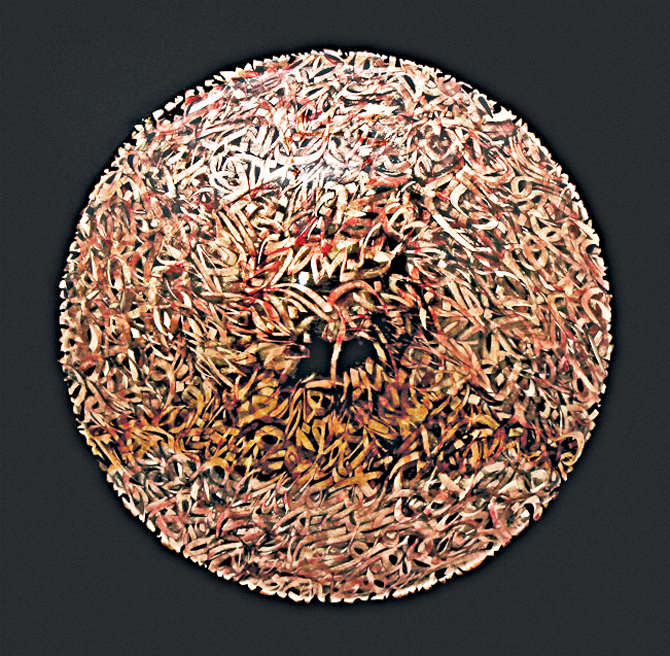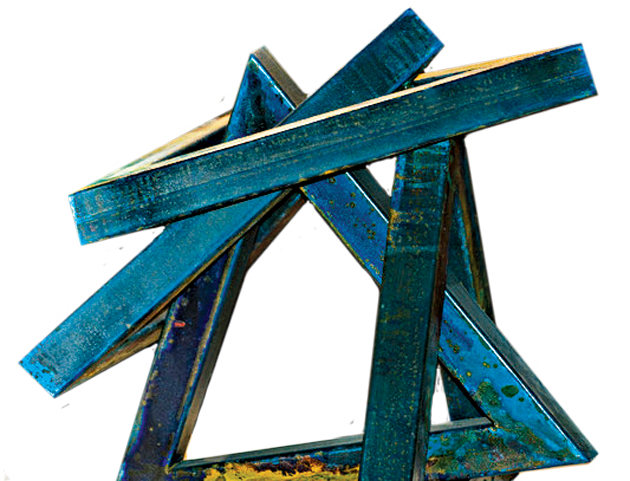RIYADH: “We wish to open new horizons toward understanding the artistic aspects surrounding us and use them to enrich the local creative content as well as the Saudi art scene,” said Reem Sultan, CEO of Misk, referring to Misk Art, a festival dedicated to the creative arts in Saudi Arabia and abroad.
Misk Art presents a fair-like setup of local and international galleries, art exhibitions, workshops and talks with the aim to empower local artists and raise community awareness about the power of creativity.
Titled “Experiment 0.3,” the third edition of Misk Art focused on how the act of experimenting through critique and research empowers creativity and the local art scene.
From Oct. 29 to Nov. 2, about 50,000 visitors visited a temporary space on King Fahad Road in the Al-Yasmin district of Riyadh.
Here they viewed works by more than 250 artists showcased amid the initiative’s various sections, including an art district, numerous specially curated exhibitions, art installations and the North East Zone, an outdoor area where bold ideas can be tested.
Among the 15 participants in Misk Art 2019 were Jeddah-based Hafez Gallery and Athr Gallery; Mono Gallery from Riyadh; Egyptian Galler Misr; Riyadh-based Hewar Art Gallery; Ella Art Gallery from Manama, Bahrain; Palette Gallery from Riyadh; Jeddah-based Nesma Art Gallery; Sharqia Arts from Riyadh and 6th Sense Gallery, also from Riyadh.

Hamza Bounoua’s ‘My World 2’. (Supplied)
Misk Art is organized by the Misk Art Institute, a platform founded in 2017 to support art and artists operating under the auspices of Misk Foundation, established by Crown Prince Mohammed bin Salman.
Misk Art 2019 was comprised of four exhibitions and about 100 workshops. It also included the second edition of its Sculpture Symposium, which saw 21 works commissioned especially for the event by sculptors from 14 countries.
“Everything was chosen based on the event’s theme to showcase experimentation,” said Sultan. “We also formed committees of well-known artists that helped to select and filter the artworks, artists, workshops and exhibitions under our supervision.”
In one of the event’s principal installations, a multitude of dead trees covered in foil by artist Abdullah Alothman entitled “Tin Farm” (2019) explored notions of collectivity and individuality through the natural phenomena of trees.
“The Tin Farm consists of a myriad of diverse trees like many souls with frozen oxygen in their veins,” said Alothman. “I exhibit trees of tinfoil in order to enter a state of lucid dreaming and artistic fantasy where the branches of the trees extend to the sky.
“Similar to fingerprints — no two are alike — every tree, every branch, every strand of grass has its own unique murmur.”
“Through experimentation we discover possibilities; through experimenting you connect with your creative soul, your unique and authentic voice; explore different realms of art, venture into unfamiliar paths and break every rule!” read a statement on this year’s theme.
What was paramount, said Sultan, was “deepening the concept of research and experience in various fields of art.”
In “Land, Medium, Idea,” artist and curator Moath Alofi created three stations exploring land, material and thoughts.
“We created three rooms; one to show the audience how Google Maps allows us to explore Saudi Arabia and how through this tool the visitor can interact and find their own unique places in the Kingdom,” said Alofi.
“The second station explored the various materials from which art can be made and the third room is like a speed-dating station for art and thoughts — like a five-minute consultancy with the artist and with me.

‘Simple yet complex’ by Maisa Shaldan. (Supplied)
“It’s a place where visitors could ask questions, discuss and explore art creation.”
In another exhibition, entitled “Flow,” Saudi artists Fahad and Talal explored the work of late 20th-century artists Andy Warhol and Jean-Michel Basquiat through a jointly created artwork that bridged different styles and ultimately asked the question: Where does one artist begin and the other end?
Perhaps, as the work demonstrated, experimentation is continuous and part of an ever-evolving cycle of inspiration and exploration.
“Contrast in Harmony,” a show curated by artist Lulwa Al-Homoud, known for her contemporary calligraphic works, similarly explored how a visual expression of harmony can be achieved by simultaneously merging contrasting elements.
“A sense of peace can be generated even through our differences,” said Al-Homoud.
Participating artists included Hala Al-Khalifa; German artist Wolfang Stiller; Egyptian Hazem El-Mestikawy; Bahraini artist Jamal Abdulrahim; Ismail Al-Rifa from Syria and silkscreen prints of Victor Vasarely (1906-1997), known as the father of Optical Art.
“Soujorn,” an exhibition curated by Kolood Al-Bakr and Abdulsalam Al-Amiri, investigates the necessity of different experiences and knowledge throughout life.
“One can never acquire knowledge without an experience or form an idea without a dialogue,” said Al-Bakr.
A sense of peace can be generated even through our differences.
Lulwa Al-Homoud, artist
“One of the factors that contributes to the quality of human life is to go through different encounters and experiences that will eventually assist in improving human growth.”
Part of the exhibition was the installation “Did you capture it?,” by videographer Tarfa Bint Fahad with music by Weirdsaudi.
The video explored how our lives have been shaped by the Instagram images we consistently seek to take and how by doing so often miss the smaller, and at times, more important aspects of our daily lives.
“Did you capture it?” is dedicated to those moments that often go missing in the constant bubble of social media snapping. As Tarfa captures life’s little details, Weirdsaudi composes a score of music that similarly adds back the forgotten sounds of those moments into our daily lives.
Art at the Misk Global Forum Art was of pivotal importance during the Misk Global Forum, which was organized by the Misk Initiative Center at the Misk Foundation and took place from Nov. 12 to Nov. 14 in Riyadh under the title “Work Reworked”
It will explore new trends and changes in the world of work in the presence or more than 140 entrepreneurs and 5,000 people from more than 120 countries.
Entitled “Presence,” the first art installation, is in the form of an interactive experience presented by Misk Art Institute to explore how one’s presence, in body and soul, influences the way they perceive the world around them.
The second, entitled “Brace,” also offered an immersive digital experience by artist Abdul Halim Radwi, showcasing through large display screens covering the room the sensation of painting.
In December, Misk Art Institute will be participating in Diriya Season with an initiative called Tajallat.
Now in its fourth edition, Tajallat is an initiative where 20 artists from all over the Kingdom are invited to take part in a live-drawing show inspired by the historic Al Turaif District, listed as a UNESCO World Heritage site.

























